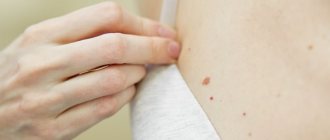Every person takes care of his body and health. At the same time, everyone wants to look seductive and stylish. And tanning helps us in this matter, because it is a wonderful way of transformation. But what to do if moles begin to appear after sunbathing?
This article will discuss: why moles appeared after a solarium or tanning in the sun, what to do if they appear.
Ultraviolet radiation is the main cause of the appearance of moles
The reasons for the appearance of moles are varied. This may be a hereditary predisposition, injury to a nevus, viruses entering the body, or the influence of hormonal changes on a person’s health. However, it is exposure to ultraviolet radiation that is considered the main factor influencing the formation of new nevi.
At its core, tanning is the body's protection from exposure to sunlight. As a result of irradiation, the number of cells that produce melanin in the skin, the pigment that is the basis of all moles, increases. Its excess leads to the formation of new nevi. Under the influence of direct sunlight, especially in summer, small moles in the form of nodules form. Excessive amounts of them are considered a dangerous factor in the development of malignant neoplasms. Therefore, if after relaxing on the beach or visiting a solarium you notice the appearance of new, even minor moles or changes in existing ones, be sure to consult a doctor. Burns can become a trigger for the development of a serious skin disease - melanoma.
How do the sun's rays affect the skin?
In small quantities - positive. “Sunlight is necessary for the synthesis of vitamin D and has a beneficial effect on mood. However, ultraviolet (UV) radiation causes a number of acute and chronic harmful effects on human skin, including sunburn, photoaging and skin cancer,” warns Svetlana Turbovskaya, PhD, allergist, immunologist, dermatovenerologist, head of the department of pediatric dermatology of the European Medical Center (EMS).
In some cases, prolonged exposure to the sun may cause skin pigmentation and moles. What is the difference? “Moles are round or oval, raised or flat spots on the skin with clear boundaries, often appearing singly throughout the year. While pigmentation is usually lighter in color than moles, it is large in size, irregular in shape and appears after skin damage and sun exposure,” adds Svetlana Turbovskaya.
The danger of moles appearing after sunbathing
Statistics show that excessive exposure to ultraviolet rays significantly increases the chances of getting melanoma, or other malignant skin tumors. After all, it has long been no secret that those with a “chocolate” tan expose themselves to an unjustified risk of getting skin swelling and early wrinkles in pursuit of beauty standards.
Melanoma is a malignant tumor that, if detected early, can be successfully treated. Therefore, immediate consultation with a doctor is necessary in order to diagnose this disease in time and prevent metastasis. Alas, statistics show that in post-Soviet countries, 95% of people die from melanoma and this happens not because this tumor cannot be cured, but because patients see a doctor too late.
Only a specialist can examine your skin both visually and using a special device - a dermatoscope, observing the changes occurring in the deeper subcutaneous layers. In addition, there is computer epiluminescent dermatoscopy - this technique allows you to identify signs of malignancy of a mole at the earliest stages.
The sun is the main enemy of moles. Why check them?
Summer is a wonderful time to relax outdoors in the open sun. Everyone strives to fully enjoy the warmth before the onset of cold weather. However, lovers of beaches and solariums run the risk of developing skin problems in addition to a beautiful tan. Ultraviolet radiation is a strong irritant with a carcinogenic effect and can lead to the formation of melanoma.
WHAT IS MELANOMA DANGEROUS?
Moles, or nevi, as doctors call them, are accumulations of melanin pigment in skin cells. Under the influence of sunlight, skin cells actively synthesize melanin - a tan appears. Intense production of melanin can lead to an increase in the number of moles on the body or increase the risk of degeneration of existing ones into a malignant tumor.
In 50% of all cases of melanoma, their appearance is caused by the degeneration of a pigmented nevus. There are congenital and acquired moles. Congenital ones appear in the first years of life and are considered safe. Nevi that appear in adolescence or older, for example, due to hormonal imbalances or exposure to the sun, are considered acquired. Such moles are those that are prone to degeneration into malignant ones, and therefore require special attention.
Melanoma is an aggressive, rapidly progressing tumor, dangerous because it affects not only the skin, but also other organs. When exposed to the sun, normal cells become abnormal, grow uncontrollably and attack healthy tissue. Cancer cells are spread by blood and lymph throughout the body, forming multiple metastases. However, melanoma is completely curable if detected at an early stage. That is why it is important to monitor the condition and number of moles on the skin.
HOW ARE MOLES EXAMINED?
You can examine moles yourself, paying attention to the appearance of signs of degeneration of a benign nevus into a malignant one. Normal moles are symmetrical in shape with smooth edges, uniform in color and not exceeding 6 millimeters in diameter.
Signs of degeneration include a change in outline, the appearance of an asymmetrical shape with a fuzzy, uneven and blurred outline. Changes in size, color, appearance of crusts, bleeding, cracks and peeling of the nevus are considered alarming signs. The appearance of even one of the listed changes is a good reason for an urgent visit to a dermatologist.
Differential diagnosis is carried out using dermatoscopy and histological examination. Having received the results of the examination, the doctor will be able to prescribe removal of the most suspicious pigment spots, as well as recommend a method that will ensure maximum comfort and safety of the procedure.
WHY ARE MOLES REMOVED?
The reason for removing a mole may be aesthetic preferences. For some, nevi are a decoration given by nature. For others, it is a flaw that greatly spoils their appearance and becomes a source of psychological complexes.
The most common reason for promptly getting rid of a mole is its inconvenient location. Moles can be injured by clothing items or interfere with walking. In some cases, nevi are located in places where it is difficult to monitor their changes, for example, in the scalp, intimate area, in areas of the mucous membrane and even under the nails.
Injuring a mole is dangerous due to infection or tumor development. If, due to carelessness, a mole was damaged, then the area should be treated with an antiseptic and the bleeding should be stopped. You should consult a doctor within two weeks after the incident.
Please note that attempting to remove a mole yourself is fraught with serious consequences. On this issue, you should always contact qualified specialists in special medical institutions.
Removal methods:
- laser burning or evaporation;
- radio wave removal;
- surgical excision.
The method of removal is selected individually depending on the clinical case.
HOW TO PROTECT YOURSELF IN SUMMER?
The best way to protect yourself from the risk of skin cancer is to reduce your exposure to the sun as much as possible. It is important to avoid ultraviolet radiation during hot sun hours. Protective clothing with long sleeves and a hat will help reduce adverse effects. It is important to use sunscreen, and, of course, avoid visiting a solarium and spending long periods on the beach.
It is advisable to check your body monthly, noting the appearance of new moles and unusual spots, and monitor changes in existing ones. Visiting a dermatologist once a year will help diagnose pathological processes in the early stages and avoid serious consequences.
Highly qualified dermatologists of the SOVA clinic carry out examinations using the latest equipment. If necessary, effective treatment will be prescribed to help keep your skin beautiful and healthy.
Signs of a nevus turning into melanoma after sunbathing:
- A line passing through the center of the nevus divides it into two asymmetrical parts;
- Moles with a diameter of more than 1 cm - such formations turn into melanoma much more often than small pigmented structures;
- The edges of the mole are fuzzy, blurred;
- The nevus has an uneven color interspersed with black, gray or pink.
It is necessary, if possible, to prevent damage to the epidermal structures of moles.
There is a group of people for whom tanning initially poses a risk of oncological transformation of moles. Risk factors:
- Blonde and red hair;
- Freckles;
- Cases of skin cancer in close relatives;
- The presence of several moles with a diameter of 6 mm.
How to check the condition of a mole
According to Svetlana Turbovskaya, you can do this yourself using the ABCDE rule.
“A” (from the English asymmetry) - asymmetry. “Danger arises if at least one axis of symmetry cannot be drawn through a mole,” says Svetlana Turbovskaya.
“B” (from the English border) - border. “An uneven, and even more so a jagged or scalloped edge of a mole causes anxiety,” notes Svetlana Turbovskaya.
“C” (from the English color) - color. “Most benign moles are brown (less often flesh-colored),” says Svetlana Turbovskaya. “A deep black color or the appearance of red, blue or white colors may signal the development of melanoma.”
“D” (from English diameter) - diameter. Most often, the size of melanoma exceeds 6 mm.
“E” (from English evolving) - change. Any changes that have occurred to the mole. “The most alarming signs are: bleeding, changes in shape, size, the appearance of a burning sensation, ulceration, hair loss from the surface of the mole, the appearance of persistent inflammation, the formation of dry crusts, the appearance of a glossy surface of the nevus, the disappearance of the skin pattern from the surface of the nevus or the moistness of the mole,” warns Svetlana Turbovskaya.
If at least one of these parameters causes you concern, we recommend visiting a dermatologist.
Preventive recommendations
If you notice suspicious changes on the skin, do not try to self-medicate, as this may lead to adverse consequences and the need for longer therapy. Remember that by ignoring a trip to the doctor, you are putting your body at great risk. An experienced specialist will help not only determine the type and danger of nevus degeneration, but also, if necessary, advise a way to remove such pigmented structures that appear after tanning.
Medical means quality medical care, the latest equipment and affordable prices. In our clinic you will receive professional advice and effective treatment that meets European standards of medical service.
Find out the cost of the procedure “Removal of tumors”
What is a mole?
From a medical point of view, a mole is a local skin defect characterized by the proliferation of capillaries or pigment cells, depending on the type. Most of these defects are harmless and can only cause cosmetic discomfort, but their existence on the body should not be taken lightly.
Video: why do people need moles?
Factors that provoke the appearance of moles:
- ultraviolet radiation;
- hormonal imbalance;
- heredity;
- menopause;
- pregnancy.
How to prevent emergence and degeneration
A person needs to understand that the fewer birthmarks on his body, the lower the risk of degeneration. We are talking about a quantitative ratio. Even one nevus can begin transformation if it is constantly subject to damage, including sunburn.
To protect yourself from the occurrence of moles and other pathological processes, you need to follow simple rules.
- In summer, you need to protect your skin with clothing.
- You should not be in the sun between 10.00 and 16.00.
- It is recommended to use sunscreen ointments or creams.
- The treatment should be carried out not only on the face and shoulders, but also on the back.
- After swimming in ponds, you need to dry yourself with a towel and then sunbathe.
- Doctors do not recommend overusing solariums.
A person cannot completely protect himself from the risk of degeneration of a mole. Several factors influence this likelihood to increase. It is forbidden to rip off or damage the nevus. The more times he is injured, the greater the threat. It is not recommended to remove tumors yourself at home; in parallel with a relapse, the likelihood of cell mutation increases. When visiting the beaches, it is recommended to cover large moles with a band-aid or a special sticker.










